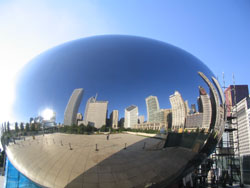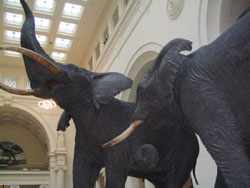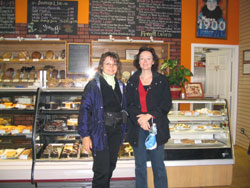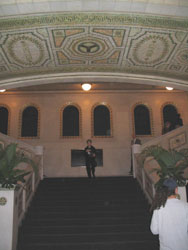Yesterday I woke up at 5:00 am Chicago time and I figured I might as well get ahead of the crowd at the Arlington House Youth Hostel and take an early shower. At 6 am I was already on the Internet, recording my first impressions of this exciting city and by 6:30 am I had left the hostel. It was still pretty dark outside and the sun was just slowly starting to come up.

Dawn in Lincoln Park
I walked through the quiet Lincoln Park neighbourhood all the way to the Lake Michigan Shoreline where the cool wind was just howling off the lake. Joggers, bicyclists and power walkers were already out in full force. I strolled around for about 15 minutes, but when the wind got too strong I decided to take a bus and head south to a neighbourhood called “Old Town”, near North Street and N. Wells Street. It’s a tidy, well-kept neighbourhood of historic homes and the location of the Second City Comedy Club, a place that has spawned so many comedic talents.
 |
 |
 |
| Old Town | Second City Improv | St. Michael’s Church |
After a brisk morning walk around Old Town I hopped back on the el-train and went to check out downtown. I got off in the Loop and headed out towards the openness of Michigan Avenue and Grant Park. Interestingly the wind in between the buildings
in the Loop was much stronger than in the open areas just off the Lake Michigan Shoreline.
Michigan Avenue and Grant Park are one of the areas where Chicago’s beauty is most striking. Daniel Burnham’s city plan of 1909 that preserved a huge amount of green space right on the shoreline of Lake Michigan was a brilliant decision, and visitors and local residents alike benefit from the huge green zone between the Loop and the lake. Grant Park’s beginnings actually date all the way back to 1835, when foresighted citizens, fearing commercial lakefront development, lobbied to protect the open space. Burnham’s vision of the park as a formal landscape with museums and civic buildings became reality: today Grant Park holds 3 of the city’s most distinguished museums: The Field Museum of Natural History, the Shedd Aquarium and the Adler Planterium.
 |
 |
| Millenium Fountain | Grant Park with Aon Building |
The Buckingham Fountain is the centerpiece of Grant Park, the city’s grand “front yard,” and it is set within a handsomely landscaped garden, one of the city’s finest examples of a Beaux-Arts-style landscape design. It is an exact replica of the fountain in Versailles, just twice as large, and with those measurements it is one of the largest free-standing fountains in the world.
At the north end of Grant Park is Millenium Park, at an investment of $495 million Chicago’s most ambitious public undertaking. Unsightly railroad tracks and parking lots were turned into a multi-media outdoor entertainment area during the last few years. Among Millennium Park’s prominent features are the Frank Gehry-designed Jay Pritzker Pavilion, the most sophisticated outdoor concert venue of its kind in the United States; a winding mirror clad bridge over Stetson Street, designed by world-renowned architect Frank Gehry; and “Cloud Gate” (“The Bean”), a hugely popular sculpture inspired by liquid mercury, designed by British artist Anish Kapoor. On this beautiful sunny morning, the reflections of the city’s skyscrapers had an almost surreal feel to them.
 |
 |
| “Cloud Gate”, a.k.a. “The Bean” | Jay Pritzker Pavillon |
I still had about an hour and a half before my friend Linda would arrive at the Randolph Street Station, so I decided to head north on Michigan Avenue towards two of my favourite buildings: the Wrigley Building and the Chicago Tribune Tower. The Wrigley building serves as the headquarters of the Wrigley (chewing gum) company and was built in 1920 by the company’s founder, William Wrigley Jr. It was the first of a series of landmarks at the southern end of the Magnificent Mile.
The design of the Tribune Tower was the result of an international competition for “the most beautiful office building in the world,” held in 1922 by the Chicago Tribune newspaper. The various competition entries proved extremely influential for the development of skyscraper architecture in the 1920s. The winning entry, with a crowning tower with flying buttresses, is derived from the design of the French cathedral of Rouen and gives the building its striking silhouette.



